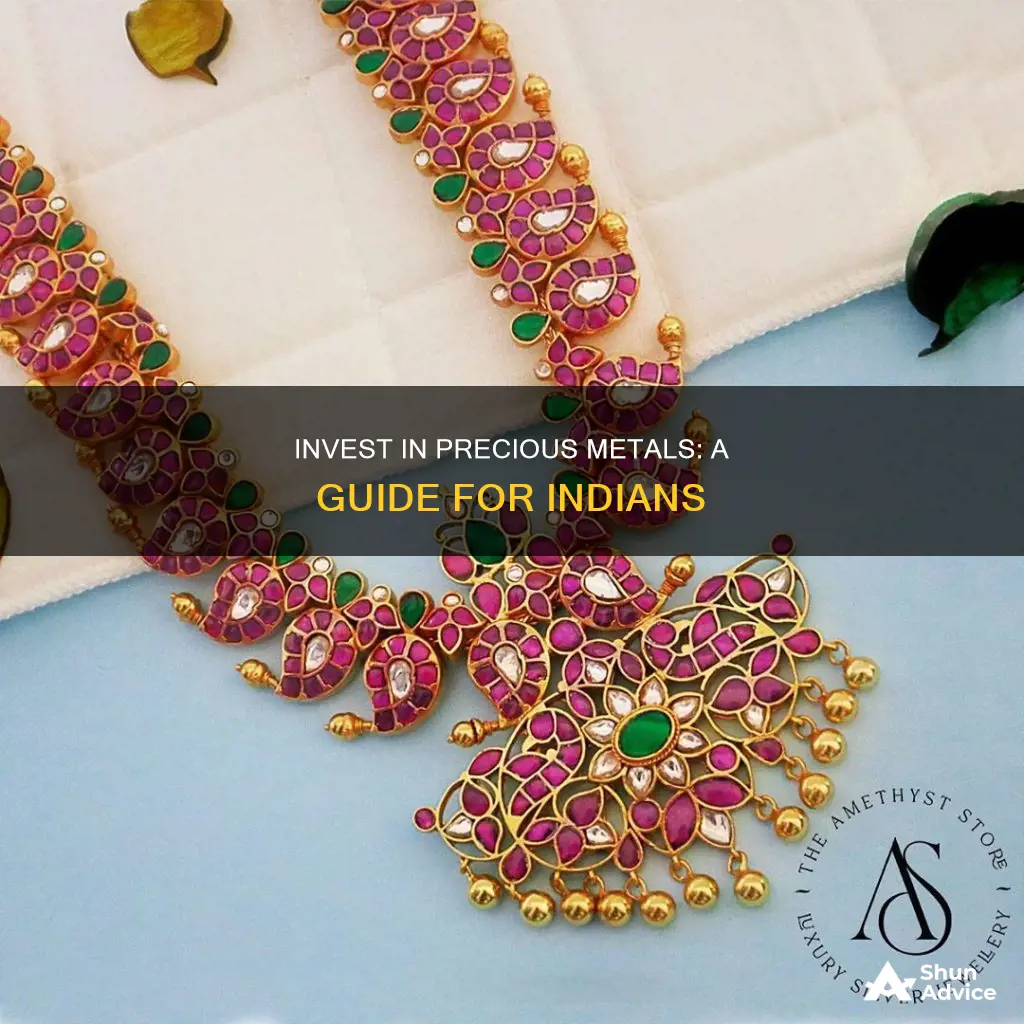
Investing in precious metals is a popular way to diversify an investor's portfolio and protect against inflation. In India, gold and silver are not only culturally significant but also hold substantial economic value. Gold, in particular, is seen as a safe investment and a hedge against inflation. Apart from gold and silver, other precious metals that can be considered for investment purposes include platinum, palladium, rhodium, iridium, ruthenium, osmium, rhenium, and indium.
There are several ways to invest in precious metals in India. One way is to buy the physical metal in the form of jewellery, coins, or bars. However, this option comes with storage and security risks. Another way to invest is through exchange-traded funds (ETFs) and sovereign gold bonds (SGBs). ETFs allow investors to capitalise on long-term capital gains by investing in funds focused on a single metal or a combination of metals. SGBs, on the other hand, are digital investments in gold issued by the Central government through the RBI, offering a fixed yield of 2.5% annually.
Additionally, investors can consider mutual funds that invest in precious metal-based securities. For those looking to invest in mining companies, equity and mutual funds are an option, although direct investment in mining stocks is generally not recommended due to the risks involved. Futures and options allow investors to hedge against future price movements and bet against possible trend reversals. Finally, certificates allow individuals to purchase precious metals without physically holding them and offer assured returns, although they may not be useful in a real disaster scenario.
| Characteristics | Values |
|---|---|
| Main precious metals | Gold, Silver, Platinum, Palladium |
| Other precious metals | Rhodium, Iridium, Ruthenium, Osmium, Rhenium, Indium |
| Gold's role in India | Gold is the most popular precious metal in India, used in jewellery and as a form of currency |
| Silver's role in India | Silver is used in Indian households as utensils or articles for worship, apart from jewellery |
| Platinum's role in India | Platinum is used in jewellery and dental work |
| Palladium's role in India | Palladium is used in dental work and groundwater treatment |
| Other ways to invest in precious metals | Exchange-traded funds (ETFs), mutual funds, bonds, derivatives, mining company stocks, commodity exchanges, futures and options, certificates, bullions |
What You'll Learn

Gold ETFs and Funds
To invest in Gold ETFs, NRIs and residents of India need a Demat account. Using a platform such as Tickertape, investors can select their preferred Gold ETF from a list of available options, sorted by parameters like CAGR 5Y, 1-yr returns, or market cap. Once the selection is made, investors can proceed to buy the Gold ETF of their choice online.
Gold ETFs are a good option for those who want to invest in gold without having to deal with the physical metal. They are also a great way to diversify an investment portfolio, as gold tends to increase in value and has low risk. Additionally, gold is often seen as a hedge against inflation and a safe haven during economic and political instability.
It is important to note that Gold ETFs do not give investors access to the physical commodity, so there is no claim on the actual gold held in the fund.
Savings Transform to Investment: When and How?
You may want to see also

Silver, Platinum, Palladium
Silver
Silver is a popular investment option in India due to its affordability compared to other precious metals. It is also relatively less risky as an investment because its prices don't fluctuate too much.
In India, silver is owned in the form of bullion (coins and bars). You can buy silver coins from banks and local jewellers, and they are a good option for small investments as they are easy to purchase and store at home. Silver bars, on the other hand, are suitable for huge investments and are easily sold due to their good demand in the market.
You can also invest in silver through the commodity market, buying silver futures, or through the National Spot Exchange, which allows you to invest in smaller chunks and hold your purchase in a Demat form.
Platinum
Platinum is regarded as an important precious metal by investors, and it is used as a hedge against inflation or a safe haven in difficult economic times. It is also valuable in industrial manufacturing, such as in cars, jewellery, and electronics.
There are two main ways to invest in platinum in India:
- Platinum bullion, coins, or jewellery: You can purchase bullion and coins from banks and authorised dealers. Platinum jewellery, however, is not a good investment option as it is not 100% pure and has high making charges.
- Futures trading on a commodity exchange: You can buy a Platinum Futures Contract (1 gram) traded on the Multi Commodity Exchange (MCX). However, this option has inherent risks, and it is only advisable for those with excess capital and an understanding of futures trading.
Another way to invest in platinum is through Exchange-Traded Funds (ETFs) and Notes (ETNs), but this product is not yet available in India.
Palladium
Palladium is a rare precious metal primarily used in industrial applications. It is also valued as a store of wealth and has investment potential due to its supply and demand fundamentals.
You can invest in palladium by buying bullion bars and coins. For example, Monex offers 10-ounce bars of .9995 fineness for personal delivery or storage through a Monex Atlas Account. You can also buy palladium bullion coins, such as the Canadian Maple Leaf coins produced by the Royal Canadian Mint.
Invest in Agnkul Cosmos: A Guide for Indians
You may want to see also

Buying bars or coins
One of the most straightforward methods of investing in precious metals is to buy bars or coins, also known as bullion. This provides the most tangible way to invest in precious metals. However, there are some downsides to this approach.
Firstly, investors will need to consider the costs of storage, transportation, and insurance, which will reduce the overall return on investment. Secondly, when buying bullion, investors will typically pay a premium over the value of the physical weight of the metal. Finally, bullion does not generate any interest or dividends, so the only way to make money is through price appreciation.
Despite these drawbacks, buying bars or coins can be a good option for those seeking a physical investment in precious metals. It is important to carefully weigh the benefits and drawbacks before making a decision.
In India, investors can buy gold in the form of jewellery, bars, or coins. However, it is important to consider the making charges, storage, and security risks associated with physical gold ownership.
Investment Managers: Guidelines for Success
You may want to see also

Buying shares in mining companies
There are two main groups of mining stocks: juniors and majors. Juniors are younger companies with less capital, shorter histories, and higher risk. They are often involved in commodity exploration, such as oil, minerals, and natural gas. Majors, on the other hand, are well-established companies with a large portfolio of claims, more stable cash flow, and a capital cushion for further exploration. They are less volatile and more mature. Examples of major mining companies include BHP, the largest mining company in the world by market cap.
When investing in mining stocks, it is important to carefully analyse the company's financial data and consider the unique risks associated with the industry, such as fluctuations in commodity prices and geopolitical factors. Two commonly used financial ratios to evaluate mining stocks are the Price to Earnings Ratio (P/E) and the Price to Book Value Ratio (P/BV).
In India, some of the top specialty mining and metals companies include KABRA COMMERCIAL, NMDC, KIOCL, and SOUTHERN MAGNESIUM & CHEMICALS. These companies can be found on the BSE and NSE stock exchanges.
Before investing in mining stocks, it is important to consider your investment goals, risk tolerance, and the overall profile of your portfolio. Mining stocks can be a good way to diversify your portfolio and hedge against market risk, especially during times of economic uncertainty.
Partnership Investment Strategies: Portfolios Over $10 Million
You may want to see also

Mutual Funds
Benefits of Investing in Gold Mutual Funds:
- Diversification: Gold funds offer investors a way to diversify their portfolios beyond traditional assets like stocks and bonds. Gold often moves independently of equities and bonds, acting as a buffer against market volatility.
- Safety and Transparency: Gold mutual funds in India are regulated by SEBI. The pricing of these funds is based on the current market value of gold, providing transparency and fair pricing for investors.
- No Need for Physical Storage: Unlike physical gold, which requires secure storage and insurance, gold funds offer a simpler way to gain exposure to gold without the logistical challenges.
- Cost-Effectiveness: Investing in gold ETFs through mutual funds can be more cost-effective than acquiring and storing physical gold. Gold funds often have lower transaction and maintenance fees.
- Liquidity: Gold funds are highly liquid, allowing investors to easily buy and sell their holdings. This liquidity can be advantageous during market volatility when quick choices may be required.
- Potential Tax Advantages: Depending on the jurisdiction, gold funds may offer tax benefits. Some countries provide tax breaks for gold investments, making gold funds more appealing.
Things to Consider Before Investing:
- Investment Goals and Horizon: Understand what you want to achieve with your investment and how long you plan to invest for. This will impact your choice of gold fund and investment strategy.
- Costs: Consider the expense ratio and exit load associated with the gold fund. These costs will impact your overall returns.
- Fund Manager's Track Record: Research the fund manager's experience and past performance to assess their ability to manage the gold fund effectively.
- Past Performance: Evaluate the historical performance of different gold funds to identify the best-suited options for your investment goals.
- Gold Funds vs. Gold ETFs: Gold ETFs have lower expense ratios and higher liquidity than gold funds. Holding gold ETFs is very similar to holding physical gold.
- Market Price Distortions: Geopolitical events and economic uncertainties can impact the returns of gold funds. The price of gold is sensitive to global events and market conditions.
- Lower Returns than Equity: Gold funds may not generate returns as high as equity mutual funds over the long term.
Popular Gold Mutual Funds in India:
- ICICI Prudential Regular Gold Savings Fund (FOF)
- Invesco India Gold ETF FoF
- Quantum Gold Savings Fund
- Aditya Birla Sun Life Gold Fund
- Nippon India Gold Savings Fund
- HDFC Gold Fund
- LIC MF Gold ETF FOF
- Axis Gold Fund
- Kotak Gold Fund
Remember to do your research, understand the risks involved, and consult a financial advisor before making any investment decisions.
Strategies to Recover from a Drop in Your Investment Portfolio
You may want to see also
Frequently asked questions
Precious metals are considered a safe investment option due to their capital protection capabilities. While their prices may fluctuate in the short term, over longer periods, they tend to increase in value in a linear fashion.
The four primary precious metals commonly invested in are gold, silver, platinum, and palladium. These metals have a range of applications, from jewellery to industrial uses, contributing to their value and investment potential.
There are several ways to invest in precious metals in India. You can consider buying physical metals such as jewellery, coins, or bars. Alternatively, you can explore investment options like exchange-traded funds (ETFs), sovereign gold bonds (SGBs), commodity exchanges, mutual funds, mining company stocks, or futures and options.
Precious metals offer benefits such as portfolio diversification, inflation hedge, and wealth preservation. They are also seen as a safe haven during economic and political instability. However, investing in precious metals carries risks, including price volatility, regulatory changes, and storage and security concerns for physical metals.







